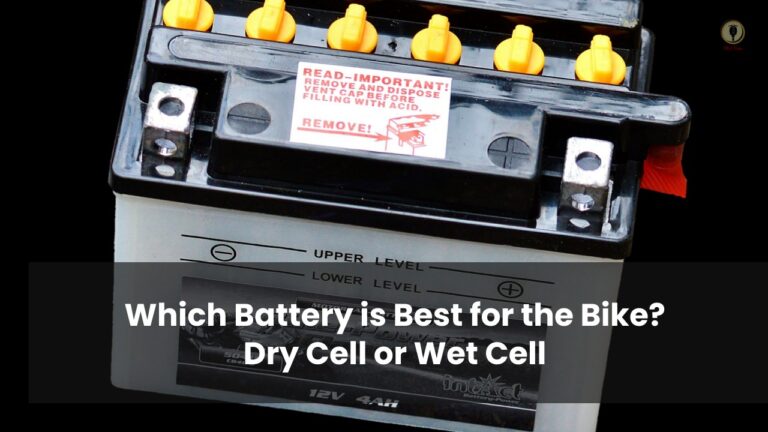Motorcycle batteries come in two different types: dry cell and wet cell. The type you choose will depend on your needs, the age of your bike, and how much money you want to spend. Dry cells are more expensive but they last longer than wet cells. Wet cells are cheaper but can be dangerous if not treated correctly due to acid leaking out of them.
Either wet or dry, they generate power for starting the engine, lighting, and acting as a bridge between the charging system and all electrical appliances in the motorcycle.
Wet cell batteries
This type of battery is called a wet cell battery because it uses water(acid) as an electrolyte (the substance that allows electricity to flow through).
Wet motorcycle batteries have electrolytes and are labeled lower and upper acid levels. It is a rechargeable battery with dilute sulfuric acid but topped with water. Lead is used as an electrode, and sulfuric acid is used as the electrolyte. Plastic material is used to separate the contact between the electrode and electrolyte.
Lead acid batteries, as the name indicates are made with a series of lead plates in an acid bath (electrolyte). They are naturally called wet cells because of the electrolyte sloshing around inside. If your battery has caps that allow access to each cell then this is a wet, lead-acid design.
Types of the wet cell batteries
1. Flooded wet batteries
Flooded batteries are traditional battery types. As the name suggests, flooded wet batteries overflow when charging. This type of battery is usually used for engine starting and deep cycle designs. They work with a liquid acid electrolyte that moves around in the cell inside the battery.
In most cases, they are not sealed. Users have to add distilled water regularly as they dry out over time.
- Typical absorption voltage: 14.4 to 14.9 volts
- Typical float voltage: 13.1 to 13.4 volts.
2. Sealed lead-acid (SLA) batteries
Sealed batteries are still basically similar in structure to flooded cells. Manufacturers have ensured there’s enough amount of material inside under normal usage throughout its warranty period that they can seal the battery. So you do not need to worry about adding more liquid electrolytes any more, and the seal on the battery ensures that acid doesn’t leak out.
- Typical absorption voltage: 14.2 to 14.7 volts
- Typical float voltage: 13.1 to 13.4 volts.
3. Valve Regulated Lead-Acid (VRLA) battery
VRLA batteries are also sealed wet batteries with valves that release hydrogen and oxygen gasses during charging. There are two primary types of VRLA batteries:
- 3-1 Absorbed Glass Mat (AGM) battery
AGM is a more advanced version of the VRLA battery. It is made up of fiberglass that is saturated in the electrolyte. AGM is unique from VRLA in that the fiber separates the electrolyte from the lead-acid plates, thus storing it in a suspended state free from the liquid.
- Typical absorption voltage: 14.4 to 15.0 volts.
- Typical float voltage: 13.2 to 13.8 volts.
- 3-2 GEL battery
It is a vent-regulated lead-acid battery that produces a small amount of gas. The gel is formed by sulfuric acid, silica gas, and lead plates inside the container. The gas produced here recombines to create water used to top up the battery; hence, there is no need for extra topping. However, GEL batteries are prone to overcharging and can burst.
- Typical absorption voltage: 14.0 to 14.2 volts.
- Typical float voltage: 13.1 to 13.3 volts.
Dry cell motorcycle battery
It is called a “dry cell” battery because there’s no water in it at all.
A dry cell motorcycle battery stores electrical energy in a gel or paste-like substance enclosed in a plastic or metal container. The electrode is a metal or graphite rod covered by electrolyte gel enclosed in the same plastic or metal container. Most dry cell batteries are stored upright to avoid leaking and keep power for a long time.
- Lithium-ion battery
It is a rechargeable battery that uses lithium ions to generate electricity. Inside the battery is positive and negative electrodes sandwiched in a plastic sheet separator submerged in an electrolyte.
The positive electrode is made of cobalt, while the negative is carbon. When charging, ions move from the positive electrode to the negative electrode and back during discharge.
Dry vs. Wet Batteries
Dry battery
Dry batteries are referred to as high performance because they have a high power-to-weight ratio. They are durable than wet though they are costly. As they are dry, they can be operated from any position without leakage.
Dry batteries can withstand high-temperature environments, thus suitable for touring. Additionally, they use non-corrosive plates, thus guaranteeing a long life.
Wet battery
A wet cell motorcycle battery is cheaper than a dry battery but lacks high-performance features for dry mortar. Also, wet batteries spill in case of misconduct but are available in a sealed maintenance-free version. They are the best choice for motorcycles used for touring purposes due to their weight.
Dry cell motorcycle battery pros and cons
Pros
- Dry cell batteries have higher power to weight ratio hence high performance.
- They are efficient due to their small size and weight.
- As opposed to a wet battery, a dry cell battery has minimal chances of leakages.
- A dry battery is an ideal backup for power to motorcycles because the electrolyte is installed inside the battery.
- They can be stored for a longer time without the fear of discharge.
- It starts working as soon as the electrolyte is installed because no initial charging is required.
- Dry cells are recycled, thus saving the environment from degradation.
- A dry battery has greater power to crank the motorcycle engine in case of cold weather.
Cons
- If your motorcycle is old, a dry battery is not the choice for the replacement.
- A dry cell battery is more expensive than a wet one due to its unique features.
- Dry cell batteries can burst if exposed to extreme temperatures, thus posing a danger to the rider though the chances are minimal.
- If a dry cell battery is incorrectly charged, it can be permanently damaged.
- If mishandled, they can break and expose the electrolyte, which is corrosive.
Wet cell motorcycle battery pros and cons
Pros
- The maintenance is easier because there is no need to install the electrolyte to operate.
- The cost of a wet cell battery is lower than a dry cell battery.
- Since the electrolyte is pre-installed, the maintenance of the battery is easier.
- They are easily topped with electrolytes and regulate the gas emission by opening the caps.
- In case of overcharging, the cells are not affected.
- They are robust and are designed to withstand overcharge.
- A wet motorcycle battery does not require a unique charging system; hence easy to charge.
Cons
- In case of mishandling or accident, the electrolyte in the wet battery cell can leak.
- If the electrolyte comes into contact with the skin, it causes corrosion and burns.
- Oxidation and reduction cause the anode and cathode to wear out.
- Thorough and regular cleaning is required to remove the sulfate deposits on the electrodes.
- Due to the electrolyte inside, wet batteries tend to be heavier than dry cells.
Primary vs. Secondary cell batteries
Motorcycle batteries are designed to be either secondary or primary cells.
Primary cells
A primary cell is a motorcycle battery that is manufactured to be used once and thrown away. They are not rechargeable and contain thick/powder electrolytes, but they have a high-density energy level. The initial cost of primary cells is cheaper than secondary cells. However, once the chemicals inside are used, they cannot be renewed.
Secondary cells
A secondary cell is a motorcycle battery that is reused once the initial charge is completed. Unlike primary cells, secondary cells have thick electrolyte which is reversed to attain charge. As a result, they are expensive but have a long life as compared to primary cells.
Motorcycle battery maintenance
Battery maintenance is simply the measure that you should take to keep your battery healthy and in cases of malfunction. Motorcycle batteries will fail to work if the recommended guidelines are not followed. For weak batteries, use a trickle or taper charger to bring it back to life though it will take a whole day to charge fully.
Dry cell motorcycle battery
If you need to store your battery, fill each cell with distilled water and check after five minutes to top up again until the marked level is reached and do not overfill. Dry cells are not rechargeable but have a long shelf life; when put into use, fill in the electrolyte and charge up to the maximum. You don’t need to check the electrolyte level in the container regularly.
Wet cell motorcycle battery
Typically, a wet cell battery is used in an upright position to avoid the spilling of electrolytes. The electrolyte level needs to be topped regularly because a low level will result in performance. The installation of electrolyte should be done at the time of use; pre-installment will damage the cells.
Clean the electrodes regularly to remove the sulfate deposits, which prevent charging. Don’t expose the battery to high temperatures as it will cause overreaction and increase leakage.
Battery care tips
- Use sandpaper to clean the battery terminals regularly to avoid corrosion.
- Check your battery electrolyte level at least once a month.
- Check for leakages after every long-distance ride.
- If your battery is a flooded acid cell type, make sure it is topped with distilled water.
- Ensure the terminals are tightly connected to the wires
- Make sure your battery is tied tightly to avoid vibrations.
- Buy a new battery if the original one freezes.
- Ride your motorbike regularly.
What are some popular battery brands?
Some popular battery brands are Everstart batteries, Napa batteries, Duralast batteries.
Bottom line
Dry and wet cell batteries are all suitable for a motorcycle, but your choice will determine which one to buy. Consider the age, the nature of usage, operating environment, and the model of your bike.
In the market today, a sealed lead acid battery is best for all motorcycles. For battery replacement, use the one specified by the motorcycle manufacturer. Keep the battery electrodes clean because dirt on it will drain the charge as it acts as a conductor. When charging, keep watching to avoid overcharging as it leads to the gradual death of your battery.

